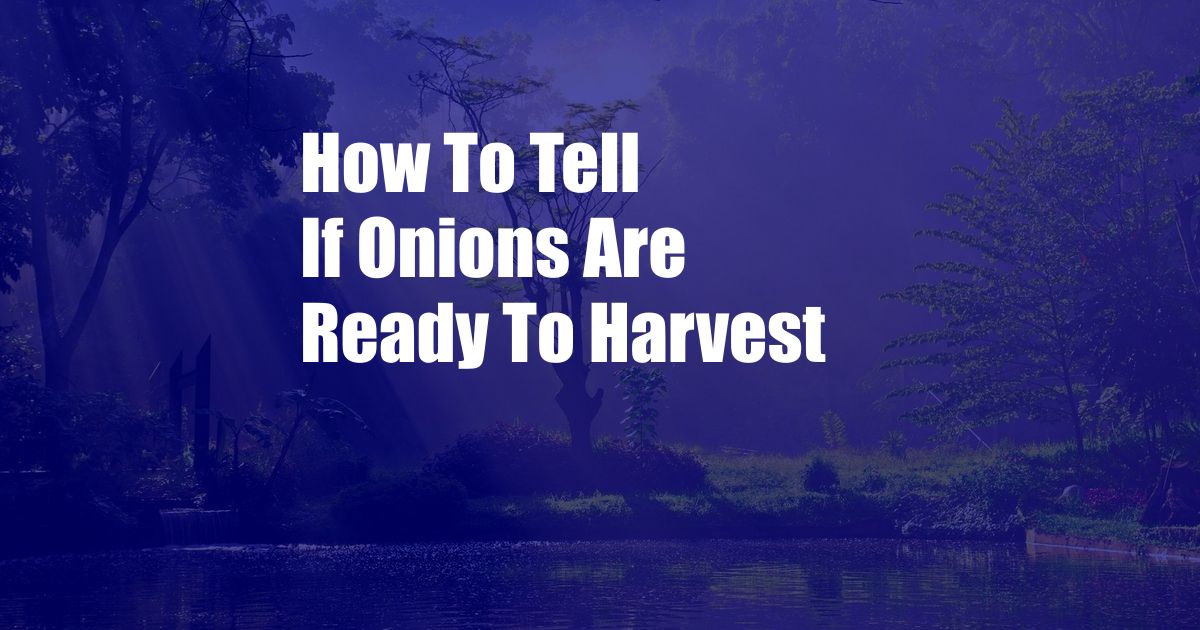
When to Harvest Onions: Unveiling the Secrets of a Perfect Harvest
I remember my first attempt at growing onions. I planted the seeds eagerly, nurtured the tiny seedlings with care, and watered them diligently. As the season progressed, the bulbs grew larger and their tops began to yellow and fall over. I couldn’t wait to harvest my first crop of onions! But how was I to know if they were ready?
Determined to unveil the secrets of a perfect harvest, I embarked on a quest to gather the wisdom of seasoned gardeners and onion experts. Through my research and personal experiences, I’ve compiled a comprehensive guide to help you determine the optimal time to harvest your onions. Read on to discover the telltale signs that your onions are ready to be plucked from the soil and enjoyed in all their culinary glory.
The Importance of Harvesting Onions at the Right Time
Harvesting onions at the correct time ensures maximum flavor, nutrition, and storability. Onions harvested prematurely may be bitter and lack the sweetness that characterizes ripe onions. Conversely, overripe onions may become puffy and start to sprout, reducing their shelf life and overall quality.
By understanding the signs of ripeness, you can optimize the harvest window and reap the rewards of well-timed onion gathering. Let’s delve into the key indicators to help you confidently determine when your onions are ready to come home.
Signs of Onion Ripeness
- Neck Collapse: As onions mature, the neck, where the bulb meets the stalk, begins to soften and collapse. This natural process is a reliable signal that the onions have reached their peak.
- Yellowing Tops: The tops of onion plants turn yellow and fall over when the bulbs have ripened. This is a result of the plant diverting nutrients to the bulb for final growth and storage.
- Papery Outer Scales: The outer scales of ripe onions become dry and papery. When you gently rub these scales off, you should reveal a thin, glossy layer beneath.
- Bulb Firmness: Ripe onions should be firm to the touch. A soft or spongy bulb indicates that the onion is not yet fully mature.
Harvesting Timeframe
The optimal harvesting time for onions varies depending on the variety and growing conditions. In general, onions are ready to harvest 100-120 days after planting. However, it’s essential to observe the signs of ripeness mentioned above to determine the precise harvest date.
In areas with a long growing season, onions can be left in the ground longer, allowing them to reach their full potential. However, in regions with shorter seasons or cold winters, it’s crucial to harvest onions before the first hard frost.
Tips and Expert Advice for Harvesting Onions
- Harvest on a dry day: Avoid harvesting onions on wet or damp days, as moisture can promote fungal growth and storage problems.
- Gently loosen the soil: Use a spade or fork to gently loosen the soil around the onion bulbs without damaging the roots.
- Pull carefully: Grasp the tops of the onions and gently pull them out of the ground. Be careful not to pull too hard, as this can damage the bulbs.
- Don’t cut the tops: Allow the onion tops to dry naturally in the sun for a few days before cutting them off. This helps prevent moisture from entering the bulbs and promotes longer storage.
- Store properly: Store harvested onions in a cool, dry, and well-ventilated place. Properly stored onions can last for several months.
FAQs on Onion Harvesting
- Q: How can I tell if my onions are too ripe?
A: Overripe onions may become puffy and start to sprout. The tops may also turn brown and dry.
- Q: What should I do if my onions have not ripened before the first frost?
A: In colder climates, onions can be harvested before they are fully ripe and stored in a cool, dry place. They will continue to ripen off the vine.
- Q: Can I eat onions with green tops?
A: Yes, green-topped onions are edible and have a milder flavor than fully ripened onions.
Conclusion
Harvesting onions at the right time is crucial for achieving optimal flavor, texture, and storability. By observing the signs of ripeness described in this guide, you can confidently determine the perfect harvest time for your onions. Remember to follow the tips provided to ensure a successful and rewarding harvest.
As you embark on your onion-growing journey, I encourage you to embrace the joy of homegrown produce. The sweet aroma and vibrant flavors of perfectly ripe onions will transform your culinary creations and add a touch of homemade goodness to your meals.